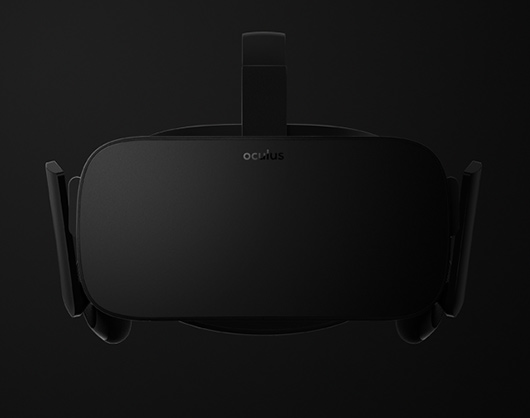Oculus Reveals Recommended Specs For Oculus Rift, Includes Core i5-4590 And GTX 970, R9 290
Lately, it seems that at every trade show or convention, we've seen Oculus demos again and again. While we had an idea of the specs needed to use the Rift, there was never a confirmation. Until now. Oculus just released the recommended system specs for using its VR device.
To begin with, users should have at least an Intel Core i5-4590 (or its AMD equivalent) or greater. For graphics, you'll want an Nvidia GTX 970 or an AMD R9 290 or better. RAM must be 8 GB, and the PC must have at least an HDMI 1.3 video output. Other requirements include two USB 3.0 ports and Windows 7 SP1 or higher for the operating system.
Obviously, VR requires a lot of graphical and processing power, and Oculus' chief architect, Atman Binstock, explained the requirements in a blog post. What it boils down to is three issues, specifically with graphics: rendering, real-time performance, and overall latency.
For rendering, the amount of shaded pixels on the Rift is vastly larger than a traditional game running at 1080p at 60 Hz.
"In contrast, the Rift runs at 2160 × 1200 at 90 Hz split over dual displays, consuming 233 million pixels per second. At the default eye-target scale, the Rift's rendering requirements go much higher: around 400 million shaded pixels per second. This means that by raw rendering costs alone, a VR game will require approximately 3x the GPU power of 1080p rendering."
Real-time performance was also an issue with the Rift because missed frames are more noticeable in VR compared to the traditional standard of PC graphics, where 30-60 frames per second is the desired framerate range. The GPU requirement is high to ensure that there is enough space in the processing to counter unexpected framerate issues when using the Rift.
The biggest issue with any VR device is latency. According to Binstock, reducing latency comes at the cost of GPU performance. Having at least a GTX 970 or R9 290 seems to be the best balance of reduced latency while still getting adequate performance from the GPU.
Get Tom's Hardware's best news and in-depth reviews, straight to your inbox.
Mac owners and Linux users will have to wait a bit longer, though. "Our development for OS X and Linux has been paused in order to focus on delivering a high quality consumer-level VR experience at launch across hardware, software, and content on Windows," wrote Binstock. "We want to get back to development for OS X and Linux but we don't have a timeline."
Binstock also noted that as the Rift evolves in the next few years, the requirements will remain the same. This means that as prices drop for those minimum required CPUs and GPUs, increasing numbers of people can more easily afford to try out VR in the coming years.
For now, PC users with enough money to spend on a high-priced graphics card, CPU and the Rift can experience it from day one, but rest assured, it's only a matter of time until VR becomes more affordable for the masses.
Follow Rexly Peñaflorida II @Heirdeux. Follow us @tomshardware, on Facebook and on Google+.
Rexly Peñaflorida is a freelance writer for Tom's Hardware covering topics such as computer hardware, video games, and general technology news.
-
SpicPeso "...at least an Intel Core i5-4590 (or its AMD equivalent) "Reply
Wait, AMD has a 4590 equivalent? :-p -
CMac019 Reply"...at least an Intel Core i5-4590 (or its AMD equivalent) "
Wait, AMD has a 4590 equivalent? :-p
That was my first thought lol... Maybe they're thinking ahead. -
TallestJon96 Came here to make the joke above, already taken...Reply
Anyway, specs seem reasonable. Lately we haven't had to many "can you run X" like we used to. A 970 an any i5 does every game really well. But with 4k and VR basically tripling GPU requirements, those high minimum specs might start to come back. -
lelutinbanni Reply"...at least an Intel Core i5-4590 (or its AMD equivalent) "
Wait, AMD has a 4590 equivalent? :-p
That was my first thought lol... Maybe they're thinking ahead.
AMD FX-8350 Eight-Core is better on Benchmarks...Noobs -
johnnycanadian ReplyAMD FX-8350 Eight-Core is better on Benchmarks...Noobs
The AMD rubbish only beats the i5 in multithreaded benchmarks. The i5 crushes the FX in single-threaded performance, which is what still counts in gaming.
-
Wolfshadw Reply15866640 said:AMD FX-8350 Eight-Core is better on Benchmarks...Noobs
The AMD rubbish only beats the i5 in multithreaded benchmarks. The i5 crushes the FX in single-threaded performance, which is what still counts in gaming.
One would hope the system and associated software packages would take advantage of however many cores/threads were available in any given system.
-Wolf sends
-
funkdat Reply"...at least an Intel Core i5-4590 (or its AMD equivalent) "
Wait, AMD has a 4590 equivalent? :-p
That was my first thought lol... Maybe they're thinking ahead.
AMD FX-8350 Eight-Core is better on Benchmarks...Noobs
No, it's not when it comes to gaming. The AMD CPU's always become bottle neck for high end GPU's. While the difference isn't huge, it wouldn't cut it for VA gaming. Maybe the next line of FXs will be good enough. -
Honis Since we're using pixels per second as a measure of demand, here is the Rift stacked with other common monitors:Reply
1920x1080 @ 60Hz (124M) Std 1080p
2160x1200 @ 90Hz (233M) Oculus Rift
2560x1600 @ 60Hz (246M) Std 2K/Pro
3440x1080 @ 60Hz (297M) Extra Wide (Note: not 2x1080p)
1920x1080 @ 144Hz (299M) Gaming 1080p
3840x2160 @ 60Hz (498M) Std 4K
5120x2880 @ 60Hz (884M) Something I found on newegg and now want.
